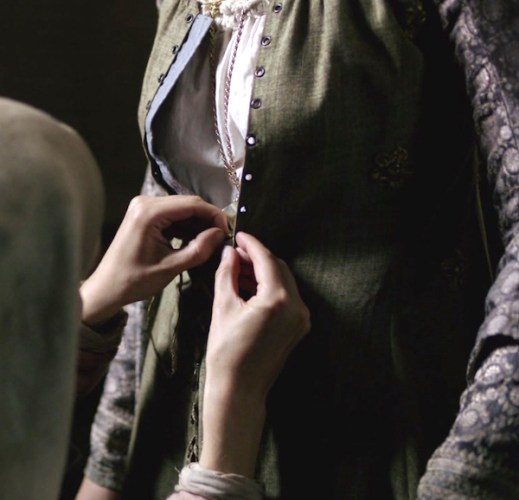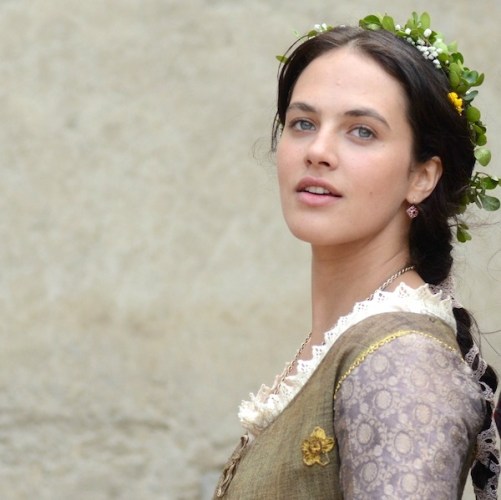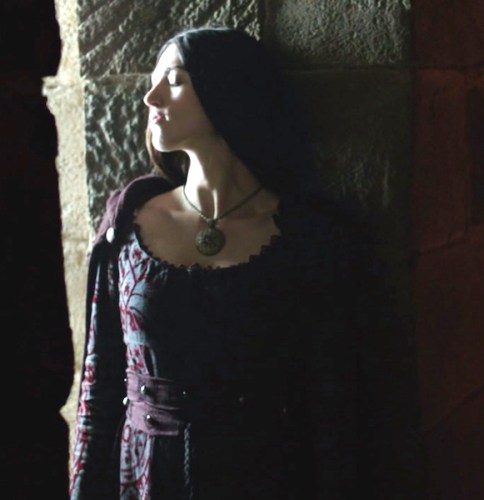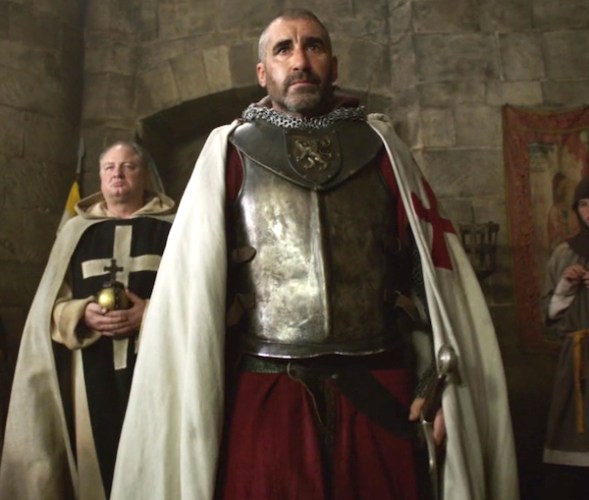
So, there I was killing time on Pinterest, like ya do, when this image floated up on my feed:

As the resident “other times that aren’t 16th-century through 19th-century” “expert” (yes, that is a lot of friendly quotes), I was kind of surprised that I hadn’t heard about Kate Mosse’s Labyrinth, which apparently came out in 2012 (and aired in the US on the CW in 2014). It’s one of those time-hopping historical novels turned historical film fluff, so maybe that’s why I missed it. Kendra usually handles that department, being the resident historical novel enthusiast around here.
The basic premise is that A) it takes place in both the 13th- and 21st-centuries; B) it deals with two women who “share a link between past and present”; and C) it was filmed on location at Carcassonne, the beautiful medieval walled castle-city in southern France that was a major stronghold of the Cathars.
Brief history lesson if you’re not familiar with the Cathars, since it is never really explained in the plot of this film … They were a Christian sect that was active for a brief period in the southern region of France between the 12th- and 14th-centuries. What made them really interesting is that they practiced a form of Christian dualism, Catharism, that held a myriad of controversial beliefs in opposition to the dominate Roman Catholic church, such as equality between the sexes, reincarnation, and the ordination of women as perfecti (basically the highest order of leadership within the faith). Pope Innocent III came down especially hard on them in the early 13th century, launching the Albigensian Crusade in 1209 with the express intention of eradicating their “heretical” practices.
Which basically doesn’t even get mentioned in the show. Instead, they’re a kind of peaceful colony of medieval hippies who have some tenuous connection with the Holy Grail. OK, it’s not like I was expecting actual scholarship here.
Moving on. Labyrinth begins right as the Albigensian Crusade is starting up. Well, OK, the actual beginning of the series is in 2012, on an archaeological dig in what looks an awful lot like the base of Montségur, the site of a stronghold where the last major battle against the Cathars occurred in 1243, about 50 miles from Carcassonne.
BTW, if you ever get the chance to visit Montségur, do not turn it down. We spent a cold, rainy day there in May 2014, and it was FABULOUS. Didn’t get the chance to climb the mountain to view the ruins on account of all the mud, but it was worth it for the awesome little British-themed pub in the village below which served one of the best cassoulets I’ve ever had. And I had a lot of cassoulet during the course of that trip.

Alice Tanner (Vanessa Kirby) is helping her archaeologist friend on a dig, and as she’s scraping around in the dirt, she uncovers a penannular brooch. This causes a disturbance in the Force which triggers an earthquake, and she hears a voice coming from the direction of a cave that’s just been revealed a short distance away. She does what any Californian can tell you is exactly what you DON’T do after an earthquake … She goes straight into the cave.

She finds a pair of skeletons right below an image of a labyrinth drawn on the cave wall and picks up a gold ring that also has a labyrinth emblem engraved on it which triggers some kind of altered state of consciousness whereby she hallucinates being stabbed in her stomach by an invisible knife and, seeking help, exits the cave to discover she’s transported back in time to the 13th century, just in time to witness scores of people being burned on a huge bonfire.
A woman makes eye contact with her and hands her a book, and then … Boom. She’s back in the 21st century being scolded by her friend for being a nitwit by going into the cave and freaking everyone out and contaminating an archaeological site and involving the police, blah blah blah. It’s not clear how the police ended up getting involved because … It’s an archaeological dig at the site of a mass execution hundreds of years before. You’d sort of expect to find human remains. But whatever, suddenly Alice is in the middle of the massive conspiracy to recover the ring she found (and lost). Well, it’s finally revealed after FOREVER that there are ReasonsTM why the authorities were suddenly all up in the archaeologists’ business.
Anyway, since we’re here to talk about the costumes, let’s skip ahead to the 13th-century portion. This part deals with the character Alaïs (Jessica Brown Findlay), younger daughter of the steward of Carcassonne. Alaïs is married to douchey chevalier Guilhem du Mas who is banging her sister, Oriane (Katie McGrath). Oriane is a bitch. Alaïs is daddy’s favorite. Guilhem is gross looking.
Also, the fact that Guilhem is having the affair with Oriane nagged at me a little bit, since upon reflection, there was really no earthly reason why he would do it. He seemed to hate her, in fact. It seemed like a poorly inserted plot device to create drama later on in the film.





Let’s just cut to the chase, shall we? Regarding the costumes, I was going into this feeling pretty neutral about the production stills I saw on Pinterest. The 13th century isn’t an easily accessible era of clothing to research, so I wasn’t holding out for hope that I’d see some really accurate stuff on screen.
Alaïs’ green gown that’s seen in the first half of the show is bog standard “medievaloid.” It’s pretty and has some cool, albeit anachronistic, touches (like the split-front skirt cut and a drop-waist seam), and of course the lead actresses all wear their hair down and flowing free, but to be fair, the 13th century was kind of a weird moment in time where uncovered hair was sort of a thing. It looked like there were attempts to use natural fibers and dyes, and everyone is wearing more than one layer, so points for that.

Then Alaïs has a costume change and OH NO THEY DIDN’T.

METAL GROMMETS??? SERIOUSLY???
“They’re such a little thing,” I’m sure you’re all thinking, “Why are you so bothered by it?”
Well, for one, we’re here to point out historical inaccuracies in film costuming, and metal grommets are about as modern as you can get. It’s only a short distance between metal grommets and zippers. Secondly, allow me to direct you all to Trystan’s personal costuming blog for a little discussion on why metal grommets are the visible panty lines of historical costuming.
It’s been years since I’ve seen a metal grommet appear in a historical flick, actually. I’m kind of hard-pressed to remember the last time, in fact [Ed. Note: That’s because Sarah didn’t see the grommet-filled clusterfrock that is Borgia: Faith an Fear, 2011-2014, not to be confused with Showtime’s The Borgias]. Metal grommets seem to have all but disappeared in historical costume movies, which is great, because they’re kind of a visual cue to those of us who pay attention to shit like this that the costumer is just dialing it in.
Frankly, of all the errors in historical costume movies, the use of metal grommets on anything set pre-19th century is something that can be laid directly at the feet of the costume department. This sort of thing is not due to some “vision” the director had, this is a choice that was made in the costume shop and it just screams IDGAF. And in a Ridley Scott-produced film, no less. This was the guy who went to insanely obsessive levels with The Duelists (1977) to get the costumes as accurate as humanly possible. I’m kind of at a loss really.
So, while I was prepared to cut a whole lot of slack for the costumes in Labyrinth, metal grommets is where I gotta draw the line. Unfortunately, now that I had gotten all worked up over the grommets, I started having a harder time ignoring the other blatant historical inaccuracies in the costumes:

And once you see one eyelet lace neckline, YOU CAN’T STOP SEEING THEM:





Also, I’d like to address the issue of necklines in general. Since the concept for the sisters’ outfits is basically “medieval-ish,” I thought I should go into more detail about why the necklines of these gowns are wrong, eyelet lace notwithstanding. So, this is the 13th century, and these girls are living a pretty privileged life within in the walls of Carcassonne, which wasn’t exactly cosmopolitan at that time (the nearby counties of Foix and Toulouse were the major cultural centers in this region), but it was a good-sized city — big enough for the Pope to try to take it down with a crusade specifically aimed at their inhabitants. How thoughtful! And so while they probably weren’t wearing the latest fashion from Paris, they were still going to be elegantly dressed. And in the 13th century, that means something like this:

Yeah, it’s a well-known fact in reenactor circles that 13th-century womenswear was kind of meh. Then again, these are actresses who could make a burlap sack look glamorous. Two of Alaïs’ dresses are a bit closer to correct than the other gowns worn by either actress:

It’s that scoop neckline that is wrong. The correct 13th-century neckline is high around the base of the neck, usually slit a few inches and held closed with a pin or brooch. As far as the hair, well, like I said above, the 13th century had this moment where young women could wear their hair down and loose, but usually with a barbette and fillet, so rarely was it completely uncovered.
These women, for instance, have their hair entirely undressed because they are lamenting:

It is worth pointing out that married women and widows, which Alaïs and Oriane are respectively, would not have had their hair uncovered. Veils, baby.

If you’re interested in viewing more 13th-century clothing, I made a Pinterest board filled with the stuff. Knock yourself out!
Now, before we continue, I just want to single out some armor. Particularly this:

My hunch was that this breastplate was wrong, and my armor nerd friends confirmed it. It’s apparently 16th century. To quote my friend Nicholas, “I have no idea what is going on with that gorget.” Ben added, “I’m not sure that’s appropriate armor for anything.” Wendy summed it up with, “Nope.”
Oh, and one other tangent. I’m pretty sure this is the café where Trystan and her hubby had lunch when we went to Carcassonne:

Anyway! Back to the 13th century! Or not!

I would like to point out that Alaïs’ Cathar servant, Rixende (Lena Dörrie), actually has the most historically accurate outfit in the whole 13th-century portion of the show:

Hair covered, higher neckline, narrow silhouette … Not too far off from this:

Typical, really. Servants and extras always get the right look.
Anyway, I don’t know if I’d recommend Kate Mosse’s Labyrinth, but it managed to (barely) hold my interest through all 180 minutes. Really, the shots of the countryside were enough to sustain me through a lot of it. I never thought I’d fall in love with France, but then I went to the Midi-Pyrénées region and ate all the cassoulet I could. It’s really a gorgeous region. I suggest you skip the film and book a ticket to Montségur and take a tour of their local museum which explains the whole Cathar thing. They even have a pair of skeletons that were unearthed there and put on display! While you’re there, in Southern France and all, check out Carcassonne because it’s pretty neat, and then definitely check out Foix for a REALLY COOL CASTLE. So much cool stuff, I need to go back.









I know I watched part of it, but it made little impression. Yes — all the armour would have been mail, not plate. Some small bits of plate were starting to come in, but not much. It was the massacre at Montsegur that led to that often misquoted, “Kill them all: God will know His own.” “Massacre at Montsegur” is one of the better books on the subject. Between 1295 & 1325 was the period that the earliest known (to date) fighting manual was written. Called “The Walpurgis Codex,” it features illustrations of a woman (presumably St Walpurga) fighting with a sword and buckler.
Thanks for the book rec! I’m getting more and more into this period of history these days, so I’m always on the look out for new reading material!
as I’m reading this–I especially take note of the comment about grommets and the 19th century and it brings to mind the Outlander wedding dress–specifically the embroidered stays which did lace up the back beautifully with what looks to be correctly finished lacing holes….but also in the front…with….I believe….metal grommets. I don’t mention it to be snarky–only because I wondered about it at the time since I had read in several different costuming books that metal grommets were not available in the mid 18th century.
The Outlander corset, at least, had what I would term metal lacing rings, rather than grommets. Grommets pierce a hole in the fabric (the hole is accurate, just, it should be sewn around rather than have metal around it). The Outlander stays had separate metal rings sewn down the front. Which isn’t something you see much of, but I feel like I’ve seen it somewhere? Or hell, maybe I was just relieved that it WASN’T grommets!
Although the type of two-piece metal grommet we use today didn’t exist, I recall reading somewhere that some corset and dress lacings were reinforced by sewing over metal rings.
They COULD be. More common was to just sew around the hole with thread.
Yep, you are correct. The so-called Effigy Stays (aka “effigy corset”) that were constructed in the early 17th century for Queen Elizabeth I’s effigy do have a few metal rings surviving in it, ostensibly to reinforces the eyelets.
But it’s still 400 years out of date for “Labyrinth” to be using anything like it. I don’t know of any need for reinforced eyelets prior to the advent of body-shaping garments like stays/corsets, since there really was no garment that tightly fitted that would require it.
“Smells like foot” — BAWHAHAHAHHAHAH. Also, that is the lead guy from “The Paradise,” whose lisp drives me crazy!
I didn’t notice a lisp, but then again, he didn’t do a whole lot of talking. Just skulking. I still don’t understand why his entire look was based around the concept of never having taken a bath in his life. THE DUDE WAS NOBILITY. THEY BATHED. EVEN IN THE 13TH CENTURY. THE END.
This movie sounds awful, but speaking of the Cathars, have you ever read the Pagan Chronicles + the followup, Babylonne? OMG they are the best books, just the best.
No, I haven’t! Thanks for the book rec! I’ll have to check them out. :)
Another thing that bothered me about this show that I couldn’t figure out how to incorporate into this review, since it has nothing to do with costuming, was the fact that Alaïs is pregnant and gives birth to her daughter around the time of the Cathar expulsion from Carcassonne, which was 1209. The plot does not bother to explain how it suddenly fast-forwards about 10 years (1219-ish) so we go from Alaïs being pregnant-but-not-showing to Alaïs having a pre-teen in literally 2 seconds. AND SHE LOOKS EXACTLY THE SAME AND IS WEARING THE SAME DRESS, SO MAJOR CONFUSION FOR THE VIEWER ENSUES. I mean, at least give her a bump so we can get the visual connection between pregnant and not pregnant but with a 10 year old child running around.
That’s not too bad on it’s own, but since I’m the sort of person who gets hung up on dates and whatnot, I noticed in one of the modern scenes where Alice is discovering HER DESTINY and finds a family tree, it shows Alaïs’ birth/death as 1193-1245, insinuating that she died in the mass-slaughter of Cathars at Montségur AT THE AGE OF FIFTY-TWO. Of course in the movie she doesn’t look a day over 25. It’s never explained, but the only thing I can do to reconcile the fact that Alaïs doesn’t age at all in the film is that she became the Grail Keeper or whatever and that gave her immortality. But again, IT’S NOT MENTIONED IN THE FILM. Also, it does nothing to explain how her sister also ends up not aging either. Really annoyed me that hair & makeup didn’t even bother to put in some gray at their temples or SOMETHING to make them appear to have advanced THIRTY YEARS OVER THE COURSE OF THE PLOT TIMELINE.
And even weirder, her daughter Bertrande is still about 10 years old when the big fight-to-the-death occurs between the sisters. How in the hell can that be explained? She would have been in her thirties at this point! ARRRRGH!
I just can’t get behind a movie that ignores it’s own plot timeline. Don’t give me dates if you don’t plan to adhere to them. :P
Random, but yes, I do think that’s the cafe outside of Carcassone where we had lunch! https://www.flickr.com/photos/trystbat/8981264674/in/album-72157633991214629/
Thought so! I remember we took a peek at the menu and I thought it looked really good. The group wanted to eat inside the castle, though.
The book on which this series was based was passed around my friends, who had all made snarky notations in the margins (many of them are archaeologists, so the 21st century dig sections got a lot of hate). The game was to get at least as far as the previous person. I have rarely encountered a dumber heroine, or more awful writing. I couldn’t even get halfway through the book – so the terrible plot holes of the show are no surprise.
Basically, if anyone is thinking of reading the book to see how it compares, DON’T. Its truly, truly terrible.
Why is Simon de Montfort dressed like one of the Knights Templar? Bah. Does he at least get his smashed in by a giant rock?
Some of that lace look like it’s bobbin lace, still freekishly out of perod though.
Will there be more episodes? So upset ATM I watched the only 2 last night after in Maine we lost power for awhile due to a strong storm and some still dont have power!so had tom watch on my cell phone. Come to find out after i got hooked no more episodes an IMDb shows that it isn’t cancelled so please some email me since i want to know if they will ever make more?
The not bathing thing isn’t as far out as all that, Nudity was considered a sin. The phrase, “died in the odour of sanctity” was quite .literal. The only time many of the more were washed naked was birth and death.
Not so. Actually medieval people loved bathing in a hot tub, and did as much of it as they could. Not many people below noble rank had the space for a whacking big coopered wooden bathtub and could afford fires big enough to heat enough water to fill it on a regular basis; but every town had public bathhouses where you could pay for a hot soak. And people had no problem with mixed nude bathing; in noble households a guest might be invited to take a bath alongside the host and/or hostess, with musicians and pages with trays of snacks in attendance
The only people who refrained from bathing were the austerer monastic orders, who felt that it was so enjoyable it counted as a fleshly indulgence.
This was THE WORST TV movie I have EVER seen!
hmmmm. maybe they got their costumes from an SCA yardsale? You know, the clothing the newbs made to have that “attempt” at pre 17th century garb and then got rid of once they learned how to garb better?